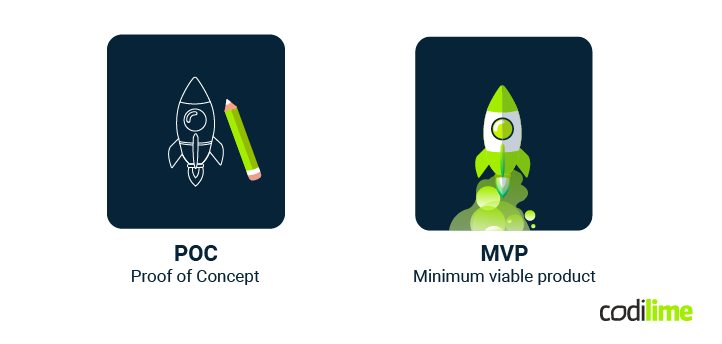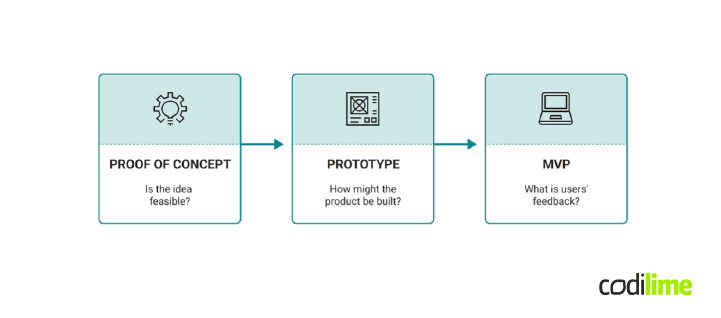Once you have an idea for a product, you need to validate it. Proof of concept and MVP are well known ways to do that. They help you assess how you can develop the product, how it can be improved and whether it’s even worth your time and resources. However, MVPs and PoCs serve different purposes and are used in differing circumstances. Read the article to learn what they are exactly, the difference between them and when to use each of them.
What is a Proof of Concept?
A proof of concept, or a PoC, is a way of validating a product’s feasibility. It’s usually one of the first steps of software product development. You take the idea you have for a product and try to produce a part of it - just to see if it’s doable, what technologies would work best, and how much time it might take. It's like a mini-experiment where developers build a small piece of a bigger idea to show that it's possible.
The goal of building a proof of concept is to test new ideas or approaches before committing to a full-scale implementation. It helps to identify potential problems, risks, and limitations early in the development process, allowing the team to make informed decisions and adjust their plans accordingly. If the POC is successful, it can serve as a baseline for the larger project. If it fails, the team can go back to where they started and try again with a new approach and new knowledge.
Main PoC features
A proof of concept is usually a small, internal project. It’s supposed to be cost-saving, which is why it needs to demonstrate certain characteristics. Here are some of the main features of a proof of concept.
- Limited scope
A PoC is a small-scale project, usually involving a small team of developers. The idea is to keep the focus on specific features, functionalities or technical requirements.
- Rapid development
A proof of concept should be developed quickly to test the idea as soon as possible. This allows developers to identify potential risks early in the development process and save resources.
- Risk reduction
A PoC is a low-risk way to explore new ideas before investing significant resources. It allows teams to identify potential problems early and make informed decisions about whether to proceed with the project or not.
- Collaborative effort
Developing a proof of concept is often a collaborative effort involving developers, stakeholders, and subject matter experts. The goal is to test the concept from different perspectives, gather feedback and make informed decisions about the feasibility of the project.
When to use a proof of concept?
A proof of concept does not comprehensively test your product concept. It only works for specific parts of it, usually concerning the technological aspects. To test the flow, the market demand, or user reception, you should opt for different methods. That being said, a proof of concept is still a useful tool for feasibility studies. You should definitely use it in the following cases.
- New technologies
When you want to explore and experiment with new technologies, tools, or platforms, a PoC helps to determine whether they are viable and can be integrated into the larger project.
- Complex systems
When a project involves complex systems or requirements, use a PoC to test specific features or functionalities before committing to a full-scale implementation.
- High-risk projects
When a project carries high risk, either in terms of cost, complexity, or technical requirements, a PoC helps to identify potential problems in the early stages of development.
- Innovative ideas
When a team has an innovative idea that has not been implemented before, a POC can be used to test its feasibility and potential before investing too many resources.
- Stakeholder agreement
When there is uncertainty or disagreement among stakeholders regarding the feasibility or potential of a project, a PoC can be used to provide evidence and gather feedback to make informed decisions.
To sum up, a PoC is most effective when used to test the feasibility of an idea that is uncertain or carries high risk. It allows developers to explore potential solutions while minimizing investment.
You can read about our PoCs on our R&D services page.
What is a Minimum Viable Product?
An MVP, or minimum viable product, is the first releasable version of a product. It contains only the features that are necessary to satisfy users’ needs and be functional. It’s not a final product, rather a starting point for gathering early feedback that guides further development.
The point of a minimum viable product is to attract early users and learn from their feedback. It allows the teams to gather data and test the market demand. Based on that information, the team can make an informed decision to develop the next features and release newer versions of the product. Because a minimum viable product only contains the most necessary features, it is a cost-friendly option that tests the assumptions about the product and the market. A significant benefit of releasing an MVP is the possibility of attracting investors - if the idea is actually viable, they will see its potential.

It’s important to remember that “minimum” doesn’t refer to quality - while a minimum viable product should be simple and only contain core features, it should still remain a quality product that a user would like to engage with.
Main MVP features
Releasing an MVP is a big step for every startup. It can make or break your product’s success, and in the best-case scenario, help you secure funding and gain a user base. When you start to build an MVP, it’s important to follow an MVP roadmap and remember its main features. A proper minimum viable product should have the following characteristics.
- Essential in functionality
An MVP includes only the core features that are necessary to meet the needs of early adopters and test the market demand. It does not include any non-essential or advanced features that can be added later.
- User-centric
An MVP is designed with a focus on delivering a simple, intuitive, and user-friendly experience. It is built to solve the user's problem or pain point and provide a quick and easy solution.
- Scalable
A minimum viable product should be easy to scale, with the ability to add more features and functionalities as the product evolves and the user base grows.
- Cost-effective
MVP development should happen in a limited time frame and not take up all of your resources.
- Feedback-driven
An MVP is built to collect early feedback, which then guides the direction in which the product will be developed.
- Test-driven
An MVP is thoroughly tested to ensure that it is stable, reliable, and meets the user's needs. This includes both technical testing, such as unit and integration testing, and user testing, such as usability testing and A/B testing. An MVP might also follow test-driven development principles to meet test requirements.
Overall, the main features of an MVP are focused on delivering a functional product that meets the user's needs, while being cost-effective and scalable. It is designed to quickly validate assumptions about the product and identify what features are most important to the user, while minimizing development costs and maximizing return on investment.
When to use an MVP?
A minimum viable product is an advanced project. While it is minimal, it still requires some knowledge and resources to have been already acquired. It is not the first step you take on your product development journey. That being said, an MVP should be developed and released when one wants to test the demand or product-market fit. You’re ready for MVP development, when:
- You’ve validated your business idea and identified your target audience,
- You’ve defined the scope of the MVP,
- You’ve gathered the necessary resources, including the team and the funding,
- You’ve decided on and tested the technologies you want to incorporate,
- You are ready to scale and develop your product further.
Overall, an MVP works best when you have already laid the groundwork. All of the above checkpoints, such as validating your idea and identifying your target users or a tech stack are a solid foundation to build a product that can be released to the public.
If you need support in creating an MVP, check out our MVP development services.
The difference between MVPs and PoCs
From the above definitions, you can already tell that MVP and PoC are quite different concepts that serve different purposes. Each of them has their own advantages. A proof of concept is a small, internal project that tests the feasibility of an idea, focused mostly on the technical aspects. An MVP on the other hand, is a releasable version of the product that is there to gather user-generated data and serves as the basis for further development. Usually, before you develop an MVP you should have tested the technologies you want to use, and that could be done via a PoC.
In the table below you’ll find an overview of the key differences between an MVP and a PoC.
| PoC | MVP | |
|---|---|---|
| Goal | To prove feasibility | To validate the idea and gather user feedback |
| Required time | Days or weeks | Months |
| Target audience | Developers and researchers | Investors and early adopters |
| Risk reduction | Reduces risk of technical issues | Reduces risk of poor market fit |
| Investment | Small budget | Large budget |
| Return on investment | None, for internal use only | Possible, if sold to early adopters |
| Future use | Usually none, serves only as a test subject | Is developed further with additional features and functionalities |
PoC vs. Prototype vs. MVP
Another method used for testing a business idea that is commonly used by startups and often compared to MVPs and PoCs is a prototype. A prototype serves yet another purpose - its main goal is to test the flow, design and user experience. It is a model of the product that visualizes its features and it doesn't require any development. It can include low-fidelity or high-fidelity wireframes designed, for example, in Figma. It is more complex than a PoC, but not as established as an MVP.
You can find a more thorough comparison of PoC vs. prototype and MVP vs. prototype in our previous articles.

All of these concepts are equally useful, but at different stages of the software development lifecycle. You can read more about it in our previous article.
There are also other ways of testing your ideas before fully investing in their development, which help you and your stakeholders visualize the product with minimal cost.
MVP vs. PoC - which one should you choose?
You can probably figure out by yourself that the choice between a PoC and MVP depends on the stage of product development, project scope, and what you actually want to test. If you’re not sure yet what technologies to use in your product, run a PoC. If you have already made that decision and taken the time to do market research and validate your ideas, go ahead and start working on an MVP.
Conclusion
Whichever option you choose, it’s crucial to acknowledge the importance of testing. Even if your MVP is already out, you might need to develop a PoC for new features or functionalities. Software development is a process of constant iteration and improvement to keep up with constantly fluctuating market needs. MVPs, PoCs, prototypes and any other ways of testing are there to save you from a failed investment. Use these tools, gather feedback and learn from your mistakes, and your product will have a greater chance of success.








